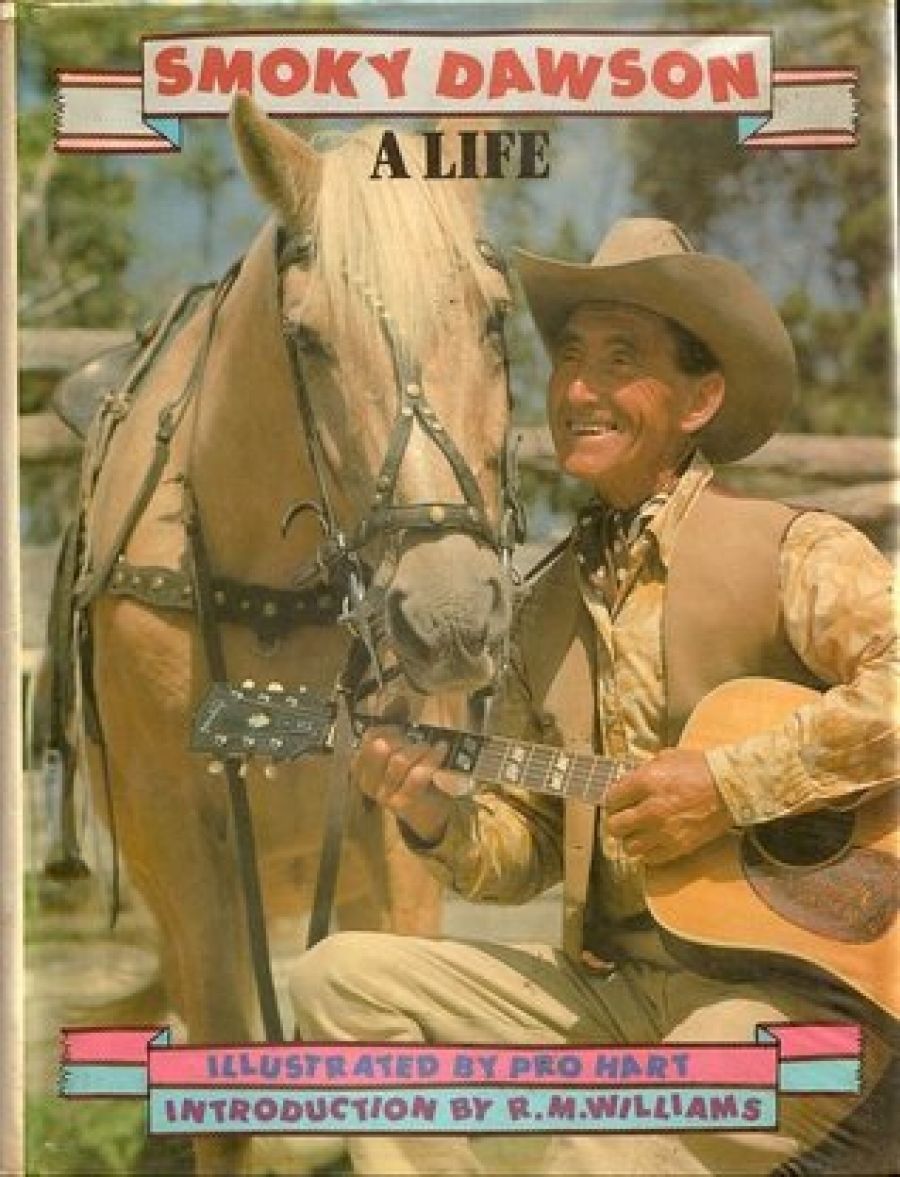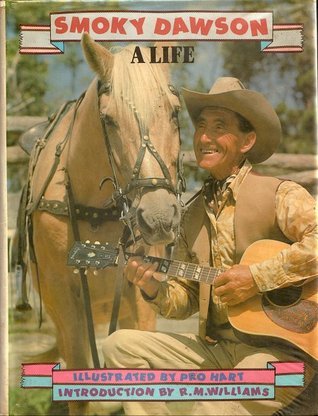
- Free Article: No
- Contents Category: Biography
- Review Article: Yes
- Article Title: Peter Pan Wore Six Guns
- Online Only: No
- Custom Highlight Text:
Smokey Dawson, a millionaire, is a Mason.
He is also a country music singer/songwriter, knife thrower, whipcracker, cartoon strip, voice in radio programs well remembered by those over 35. He is still a kind of media institution reincurring the value of … precisely what? Cowboy kitsch?
- Book 1 Title: Smokey Dawson
- Book 1 Subtitle: A Life
- Book 1 Biblio: George Allen & Unwin $19.95 pb, 237 pp
- Book 1 Cover Small (400 x 600):

- Book 1 Cover (800 x 1200):

Reading his autobiography, one has a growing sense of bafflement. What was it all for? Certainly he lived with great vitality and enjoyment, often. And it takes great skill to throw knives at people for years and not draw blood. Yet pages of the book are devoted to the time he lost a kangaroo in New York and newspapers went ape over the hunt for the exotic animal. Posterity doesn’t need to know this in great detail.
Dawson’s career resounded to the on-stage, attention-getting sound of the whipcrack. This book resounds to a different noise – that of contact between self-absorption and opportunity. During his career he had an unbelievable string of typical show-biz lucky breaks, ending in his being awarded an MBE.
Still, he owes his career to grit, pluck, talent, versatility, changing with the times, and an eye for main chances that sometimes humorously came unstuck. He had the devotion of a shrew and affectionate wife. (They had no children.) If he impressed generations of media people, he must also have had charm.
In Dawson’s life there seems to have been no great distinction between frontstage and backstage at all. It appears he was quietly, though relentlessly, upfront all the time. He appears a decent man with a love of children expressed in entertaining them. Very worthy. It is likely his creations have never meant much, culturally, except to children. This may be why – unusual for a book on a recording star – no discography is listed. But there is a long list of people he wishes to thank.
If this book is to be taken seriously, there’s an acute artistic problem. Cowboys aren’t native to Australia. So how does a country boy from old Melbourne remain a cowboy at 70-odd?
Dawson has been a professional Australian in America and back home he’s been blossoming as a pseudo-American. Has there been a prostitution of cultural identity sponsored by Kellogs and Pepsodent, complete with built-in American 50s codes of wholesomeness?
Well, applause is addictive, and maybe Dawson failed to believe people could actually dislike him. It is worthy to entertain children and make their faces shine. One wonders why this book was published. Children will hardly buy it. Adults will notice how much praise there is of Dawson’s helpers, how little notice of his competitors, Slim Dusty, Buddy Williams, Tex Morton. Dawson was always able to accommodate himself to audience requirements. He has played to invisible radio audiences, children, to the Australian country showground circuit along with Jimmy Sharman and Slim Dusty and ferris wheels, to Aussie and Yankee soldiers during WWII. He has learned and unlearned an American accent on cue. He does wax well (and quite correctly) about royalty problems; too little recognition for Australian artists; and a number of income problems he avoided by being pseudo-American. His definition of folk music is correct, but he sang little of it. There is a feeling in country music circles his work was ‘a little out of the mainstream’.
Yet, many of his anecdotes have the feel of the event. Such as the time a thrown rodeo rider had his scalp clipped by flailing hooves and he risked having his brains literally spilled in the dirt. Someone dashed in, threw himself over the prone body, holding scalp to head; the rider lived to recover. Dawson drops such tales with the unnerving casualness of the everyday.
This life is streets ahead of the less-than-one-dimensional John Lapsley biography
of Slim Dusty, Walk a Country Mile. That treatment has nowhere the human appeal of Dawson’s story. One cringes at how he lost his mother early: at his father, a genuine mongrel of a man, a vicious, tortured, guilt-ridden child abuser who once nearly strangled Herbie. There must have been great satisfaction when, as a late teenager, Smokey flattened the bastard, who later ‘got religion’ and became mystical.
These family matters Dawson has now deeply understood.
If the child is father to the man, Smokey’s wife Dot touched the matter when she once said, ‘You’re a very lucky man to be able to carry on with your boyhood fantasies and get away with it’. All the rest falls into place. It seems most of the talent he has later displayed was based on experience he had living with country people following disruption to his own family life; he learned bush life, lounge room music fun, dance hall psychology, how to mimic animals, ride horses, and so on. All he needed was Gene Autry as a model. Meeting people who’d known Ned Kelly was his introduction to ‘Australian heritage’ it seems. It is not hard to see which influence won, to Dawson’s profit.
One hears that following his autobiography is a $4 million TV miniseries. But why? Meanwhile, Pro Hart’s attractively coloured plates in the book have a curiously static quality at odds with the liveliness Dawson conveys.
The book production, well-illustrated, is superb.


Comments powered by CComment